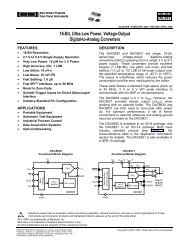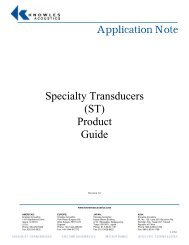AD7714* 3 V/5 V, CMOS, 500 µA Signal Conditioning ADC - dreamm
AD7714* 3 V/5 V, CMOS, 500 µA Signal Conditioning ADC - dreamm
AD7714* 3 V/5 V, CMOS, 500 µA Signal Conditioning ADC - dreamm
Create successful ePaper yourself
Turn your PDF publications into a flip-book with our unique Google optimized e-Paper software.
AD7714<br />
I DD with V DD voltage for both a 1 MHz external clock and a<br />
2.4576 MHz external clock at +25°C. The AD7714 is operated<br />
in unbuffered mode and the internal boost bit on the part is<br />
turned off. The relationship shows that the I DD is minimized by<br />
operating the part with lower V DD voltages. I DD on the AD7714<br />
is also minimized by using an external master clock or by optimizing<br />
external components when using the on-chip oscillator<br />
circuit.<br />
SUPPLY CURRENT (AV DD & DV DD ) – mA<br />
1.0<br />
0.9<br />
0.8<br />
0.7<br />
0.6<br />
0.5<br />
0.4<br />
0.3<br />
0.2<br />
0.1<br />
0<br />
2.85<br />
MCLK IN = 2.4576MHz<br />
MCLK IN = 1MHz<br />
3.15 3.45 3.75 4.05 4.35 4.65 4.95 5.25<br />
SUPPLY VOLTAGE (AV DD & DV DD ) – Volts<br />
Figure 5. I DD vs. Supply Voltage<br />
Grounding and Layout<br />
Since the analog inputs and reference input are differential,<br />
most of the voltages in the analog modulator are common-mode<br />
voltages. The excellent Common-Mode Rejection of the part<br />
will remove common-mode noise on these inputs. The analog<br />
and digital supplies to the AD7714 are independent and separately<br />
pinned out to minimize coupling between the analog and<br />
digital sections of the device. The digital filter will provide<br />
rejection of broadband noise on the power supplies, except at<br />
integer multiples of the modulator sampling frequency. The<br />
digital filter also removes noise from the analog and reference<br />
inputs provided those noise sources do not saturate the analog<br />
modulator. As a result, the AD7714 is more immune to noise<br />
interference that a conventional high resolution converter. However,<br />
because the resolution of the AD7714 is so high and the<br />
noise levels from the AD7714 so low, care must be taken with<br />
regard to grounding and layout.<br />
The printed circuit board which houses the AD7714 should be<br />
designed such that the analog and digital sections are separated<br />
and confined to certain areas of the board. This facilitates the<br />
use of ground planes which can be separated easily. A minimum<br />
etch technique is generally best for ground planes as it gives the<br />
best shielding. Digital and analog ground planes should only be<br />
joined in one place. If the AD7714 is the only device requiring<br />
an AGND to DGND connection, then the ground planes<br />
should be connected at the AGND and DGND pins of the<br />
AD7714. If the AD7714 is in a system where multiple devices<br />
require AGND to DGND connections, the connection should<br />
still be made at one point only, a star ground point which<br />
should be established as close as possible to the AD7714.<br />
Avoid running digital lines under the device as these will couple<br />
noise onto the die. The analog ground plane should be allowed<br />
to run under the AD7714 to avoid noise coupling. The power<br />
supply lines to the AD7714 should use as large a trace as possible<br />
to provide low impedance paths and reduce the effects of<br />
glitches on the power supply line. Fast switching signals like<br />
clocks should be shielded with digital ground to avoid radiating<br />
noise to other sections of the board and clock signals should<br />
never be run near the analog inputs. Avoid crossover of digital<br />
and analog signals. Traces on opposite sides of the board should<br />
run at right angles to each other. This will reduce the effects of<br />
feedthrough through the board. A microstrip technique is by far<br />
the best but is not always possible with a double-sided board. In<br />
this technique, the component side of the board is dedicated to<br />
ground planes while signals are placed on the solder side.<br />
Good decoupling is important when using high resolution<br />
<strong>ADC</strong>s. All analog supplies should be decoupled with 10 µF tantalum<br />
in parallel with 0.1 µF capacitors to AGND. To achieve<br />
the best from these decoupling components, they have to be<br />
placed as close as possible to the device, ideally right up against<br />
the device. All logic chips should be decoupled with 0.1 µF disc<br />
ceramic capacitors to DGND. In systems where a common supply<br />
voltage is used to drive both the AV DD and DV DD of the<br />
AD7714, it is recommended that the system’s AV DD supply is<br />
used. This supply should have the recommended analog supply<br />
decoupling capacitors between the AV DD pin of the AD7714<br />
and AGND and the recommended digital supply decoupling<br />
capacitor between the DV DD pin of the AD7714 and DGND.<br />
Evaluating the AD7714 Performance<br />
The recommended layout for the AD7714 is outlined in the<br />
evaluation board for the AD7714. The evaluation board package<br />
includes a fully assembled and tested evaluation board,<br />
documentation, software for controlling the board over the<br />
printer port of a PC and software for analyzing the AD7714’s<br />
performance on the PC. For the AD7714-5, the evaluation<br />
board order number is EVAL-AD7714-5EB and for the<br />
AD7714-3, the order number is EVAL-AD7714-3EB.<br />
Noise levels in the signals applied to the AD7714 may also<br />
affect performance of the part. The AD7714 allows two techniques<br />
for evaluating the true performance of the part, independent<br />
of the analog input signal. These schemes should be used<br />
after a calibration has been performed on the part.<br />
The first of these is to select the AIN6/AIN6 input channel<br />
arrangement. In this case, the differential inputs to the AD7714<br />
are internally shorted together to provide a zero differential voltage<br />
for the analog modulator. External to the device, the AIN6<br />
input should be connected to a voltage which is within the<br />
allowable common-mode range of the part.<br />
The second scheme is to evaluate the part with a voltage near<br />
the input full scale voltage for a gain of 1. To do this, the reference<br />
voltage for the part should be applied to the analog input.<br />
This will give a fixed full-scale reading from the device. If the<br />
zero-scale calibration coefficient is now read from the device,<br />
increased by a number equivalent to about 200 decimal and this<br />
value reloaded to the zero-scale calibration register, the input<br />
range will be offset such that a voltage equal to reference voltage<br />
–26–<br />
REV. B















